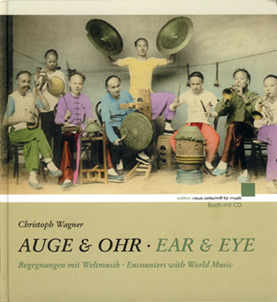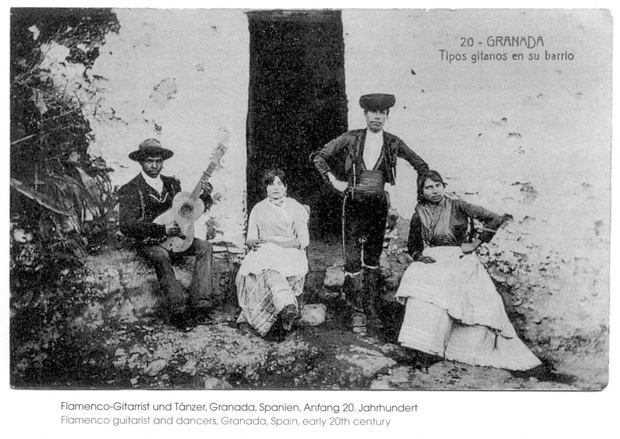Meine Frau brachte
mich mit Flamenco in Berührung, weil sie gerne nach
Spanien reiste. Obwohl wir nach Nordspanien gingen, trafen
wir dort im Umland von Barcelona auf eine andalusische Gemeinde
von beachtlicher Größe, die aus dem armen ländlichen
Süden in den industrialisierten Norden gezogen war.
Auswanderer haben ein viel leidenschaftlicheres Verhältnis
zu ihrer Kultur als die Leute, die dort leben, wo sie geboren
sind. In der arbeitsfreien Zeit fanden in den Dörfern
um Barcelona kleine Zusammenkünfte (penas) statt, wobei
eine freundliche Rivalität darüber ausgetragen
wurde, welches die Heimat des besten Flamenco sei: Cordoba,
Sevilla oder Granada.
Was mir als Flüchtling aus der Rockmusik als erstes
auffiel, war, dass bei den Zusammenkünften, die in
einfachen Räumen stattfanden, alle Generationen anwesend
waren. Großmütter und Großväter starrten
dabei wie versteinert die jungen Leute an und pflegten -
wobei sie auf die Jungen zeigten - zu sagen: "Die singen
gerne, habe aber keine Ahnung!" Erst am Ende eines
Abends standen sie manchmal auf, um diesen fantastischen
hohen Gesang anzustimmen. Die alten Leute waren wie guter
Wein: mit dem Alter wurden sie besser und besser. Alle erkannten
das an. Natürlich gab es auch Kinder und sexy junge
Frauen und Männer, die brillant waren. In dieser Kultur
schien Raum für jedes Alter zu sein.
Die Tänze waren hauptsächlich Tänze der Zigeuner,
die oft Teile der Kultur eines Landes länger bewahren
als die Sesshaften. Sie leben in einer Art Zeitkapsel. Als
wir dort waren, liefen die Zigeunerinnen in Stockelschuhen,
engen Röcken, Pelzmänteln und toupiertem Haar
herum, während die spanischen Frauen alle Feministinnen
in Jeans waren. Trotzdem waren diese Zigeunerinnen hartgesotten
und ließen sich von den Männer nichts gefallen.
Der Flamenco hört sich für mich alles andere als
europaïsch an, abgesehen von der Tatsache, dass die
Gitarrenakkorde temperiert gestimmt werden. Aber der Gesangs
passt nicht in dieses System.
Es ist faszinierend zu hören, wie die Sänger absolut
sicher die Räume zwischen den Noten finden, was man
normalerweise als verstimmt bezeichnet würde. Diese
Gesang wird hier aber mit einer solchen Autorität praktiziert,
dass klar wird: "verstimmt" gibt es nicht. Jeder
kennt die exakten Töne. Es ist eine Musik, die noch
nicht gezähmt ist. Außerdem besitzt sie eine
ungeheure Disziplin. Als Musiker, der früher recht
schwierige Musik machte, war ich überrascht, eine Volksmusik
zu finden, die derart knifflig war - allein schon rhythmisch.
In dieser Tradition gibt es verschiedene Liedformen, die
auf Tänzen beruhen. Einige sind sehr langsam, jenseits
eines Tempos, andere sind kubanisch beeinflusst, wieder
andere mexikanisch.
Die pure Intensität des Gesangs steht in deutlichem
Kontrast zu modernem Singen, das von der Annahme ausgeht,
ein Mikrofon zu benutzen, wodurch die alte Fähigkeit
richtig laut zu singen verloren geht. Im Flamenco wird sie
noch benötigt. Es ist rohe Soulmusik.
Da der Flamenco spezifisch spanisch ist, kann man davon
ausgehen, dass einige spanische Folktraditionen in ihn eingeflossen
sind. Und da Andalusien über Jahrhunderte das Juwel
in der Krone des islamischen Reiches war, scheint Flamenco
auch bestimmte arabische Einflüsse zu besitzen, Einflüsse
von Kunstmusik der verfeinertsten Art. Diese Einflüsse
wirkten auf die lokalen Tänze ein und daraus scheint
der spezifische Flamenco-Stil entstanden zu sein. Es ist
also eine Kultur, die die Grenzen und Beschränkungen
des europäischen Notensystems sprengt, und jeder, der
an sogenannter Avantgarde-Musik interessiert ist, sollte
die Überzeugungskraft bewundern, die den Flamenco davon
abhält, jemals in ein europäisches Klischee zu
passen.
| |
Robert Wyatt is a singer and songwriter who plavs
the drums, keyboards, trumpet and bass guitar. He
was born in 1945 in Bristol, England and became a
member of The Wild Flowers in 1964.
In 1966 he was a founding member of Soft Machine and
worked with the band as drummer and singer until 1971.
In 1971 he started a solo career and recorded his
first solo album. From 1971 to 1973 he was leader
of jazz-rock band Matching Mole. From 1974 he has
released several solo albums and worked with Kevin
Ayers, Carla Bley, Brian Eno, Paul Weller, Phil Manzanera,
Dave Mason, Elvis Costello and Mike Oldfield.
He lives in Louth, Lincolnshire, England.
Selected discography
Cuckooland (Hannibal/Rykodisc HNCD 1468)
Dondestan (Hannibal/Rykodisc HNCD 1436)
Shleep (Hannibal/Rykodisc HNCD 1418)
|
|
|
|
My wife introduced
me to Flamenco first because she liked to go to Spain. Although
we would only go to the north of Spain, there is so much
internal immigration where people from the poorer rural
south have gone to find work in the industrial north. So
there is a sizeable Andalusian community around Barcelona.
In some ways immigrants are more passionate about sustaining
their culture than people who still live where they come
from. So these Southerners now found themselves in the villages
around Barcelona, and when they were not working they had
their social occasions called peñas. There
was friendly rivalry about which is the real home of the
best Flamenco: Cordoba, Seville or Granada.
We were caught in a fascinating social world. The first
thing I noticed as a refugee from rock music was that at
a peña every generation would be represented
in a very simple room: there would be the grandfather and
grandmothers starring stonily at the young people. They
said: they love to sing but they don't know anything talking
about the younger generation. At the end of the evening
sometimes they would get up and you would get this fantastic
sort of high singing. These old people were like good wine:
they got better and better. That was accepted by everybody.
There were also childrend who were brilliant, and sexy young
women and men - there seemed to be room in this culture
for every age.
Nearly all dances seemed to be gypsy dances. What gypsies
often seem to do is to preserve a bit of the culture in
the country where they live, longer than the natives. They
live in a kind of time warp. When we were there the gypsy
women were going around in high heeled shoes, tight skirts
and fur coats and big hair, while the Spanish women were
all feminists in jeans. But these gypsy women were tough
cookies and any men who stepped out of line got a real earful.
The music itself is just not anything which I would call
European, apart from the fact that it is anchored in guitar
chords and the guitar is tuned, as all European instruments
are. But for the singing it's clear that the notes are definitely
not quite part of that. It is fascinating to hear the singing.
The singers are very secure in finding the spaces between
the notes which would be considered out of tune, and that's
done with such authority that you notice there is no such
thing as out of tune. Everybody knows it. But they are just
playing music that hasn't been tamed yet. It's anchored
but not tamed. It takes enormous discipline. As a musician
who used to play music which was quite difficult to learn,
I was impressed to find a folk music that was so difficult
to follow even rhythmically. If you tried to clap along
as a tourist you have to be careful.
You have to know where you are clapping and where the beats
are.
There are various types of songs, based on dance. Some
are very slow - out of tempo. Some are rather Cuban influenced,
Mexican influenced.
The sheer power of the singing is in such contrast to
modern singing which is based on the assumption that you
have a microphone. That has been a big influence on singing,
because it means that the old discipline where everybody
had to learn to sing extremely loud doesn't often apply.
But in Flamenco it definitely does. It's raw soul music.
Flamenco is especially Spanish in a strange way. It has
definitely absorbed some Spanish folk tradition but there
are also a lot of Arabic influences. Because Andalusia
was the jewel in the crown of the Islamic empire in its
heyday and was Islamic for a very long time, there seems
to be a very specific Arabic input of art music of the
most refined type. It has filtered through the local dances
and that seems to be really where the distinctive Flamenco
style derives from. So it's a culture that cannot be identified
as specifically European. It bursts the boundaries and
the limits set upon it by the harmonic major-minor scales
of European music. It is a defined stand from outside.
Anybody who is interested in avant garde culture should
admire the strength of conviction which stops Flamenco
ever quite fitting into an European stereotype.
|



